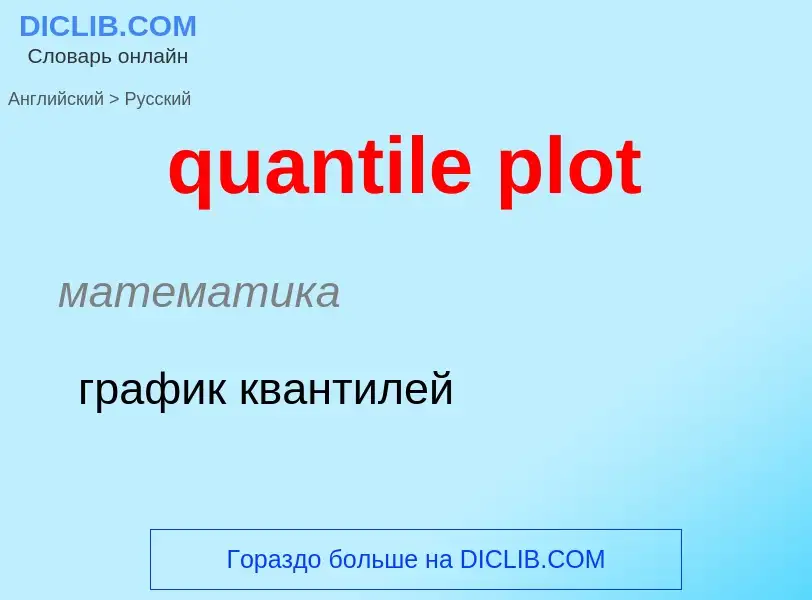Tradução e análise de palavras por inteligência artificial ChatGPT
Nesta página você pode obter uma análise detalhada de uma palavra ou frase, produzida usando a melhor tecnologia de inteligência artificial até o momento:
- como a palavra é usada
- frequência de uso
- é usado com mais frequência na fala oral ou escrita
- opções de tradução de palavras
- exemplos de uso (várias frases com tradução)
- etimologia
quantile plot - tradução para russo
математика
график квантилей
[,gʌnpaudə'plɔt]
общая лексика
"Пороховой заговор" (5 ноября 1605; был устроен католиками с целью убийства короля Якова I [James I], кот. должен был прибыть на заседание парламента [Parliament]; под здание парламента подложили бочки с порохом; заговор был раскрыт)
синоним
Definição
Wikipédia
In statistics, a Q–Q plot (quantile-quantile plot) is a probability plot, a graphical method for comparing two probability distributions by plotting their quantiles against each other. A point (x, y) on the plot corresponds to one of the quantiles of the second distribution (y-coordinate) plotted against the same quantile of the first distribution (x-coordinate). This defines a parametric curve where the parameter is the index of the quantile interval.
If the two distributions being compared are similar, the points in the Q–Q plot will approximately lie on the identity line y = x. If the distributions are linearly related, the points in the Q–Q plot will approximately lie on a line, but not necessarily on the line y = x. Q–Q plots can also be used as a graphical means of estimating parameters in a location-scale family of distributions.
A Q–Q plot is used to compare the shapes of distributions, providing a graphical view of how properties such as location, scale, and skewness are similar or different in the two distributions. Q–Q plots can be used to compare collections of data, or theoretical distributions. The use of Q–Q plots to compare two samples of data can be viewed as a non-parametric approach to comparing their underlying distributions. A Q–Q plot is generally more diagnostic than comparing the samples' histograms, but is less widely known. Q–Q plots are commonly used to compare a data set to a theoretical model. This can provide an assessment of goodness of fit that is graphical, rather than reducing to a numerical summary statistic. Q–Q plots are also used to compare two theoretical distributions to each other. Since Q–Q plots compare distributions, there is no need for the values to be observed as pairs, as in a scatter plot, or even for the numbers of values in the two groups being compared to be equal.
The term "probability plot" sometimes refers specifically to a Q–Q plot, sometimes to a more general class of plots, and sometimes to the less commonly used P–P plot. The probability plot correlation coefficient plot (PPCC plot) is a quantity derived from the idea of Q–Q plots, which measures the agreement of a fitted distribution with observed data and which is sometimes used as a means of fitting a distribution to data.



![[[Bonfire]]s are lit in Britain every 5 November to commemorate the failure of the plot. [[Bonfire]]s are lit in Britain every 5 November to commemorate the failure of the plot.](https://commons.wikimedia.org/wiki/Special:FilePath/6 november bonfire from flickr user sjnikon.jpg?width=200)
![torture rack]] in the Tower of London torture rack]] in the Tower of London](https://commons.wikimedia.org/wiki/Special:FilePath/A Torture Rack.jpg?width=200)
![William Capon's map of Parliament clearly labels the [[undercroft]] used by "Guy Vaux" to store the gunpowder. William Capon's map of Parliament clearly labels the [[undercroft]] used by "Guy Vaux" to store the gunpowder.](https://commons.wikimedia.org/wiki/Special:FilePath/Capon map of parliament.jpg?width=200)
![[[Edward Coke]] conducted the interrogations of those thought to be involved with the conspiracy. [[Edward Coke]] conducted the interrogations of those thought to be involved with the conspiracy.](https://commons.wikimedia.org/wiki/Special:FilePath/Edward coke.jpg?width=200)
![Elizabeth]], whom the conspirators planned to install on the throne as a Catholic queen. Portrait by [[Robert Peake the Elder]], [[National Maritime Museum]]. Elizabeth]], whom the conspirators planned to install on the throne as a Catholic queen. Portrait by [[Robert Peake the Elder]], [[National Maritime Museum]].](https://commons.wikimedia.org/wiki/Special:FilePath/Eliz bohemia 2.jpg?width=200)
![[[Elizabeth I]], queen from 1558 to 1603 [[Elizabeth I]], queen from 1558 to 1603](https://commons.wikimedia.org/wiki/Special:FilePath/Elizabeth I George Gower.jpg?width=200)


![''The Discovery of the Gunpowder Plot and the Taking of Guy Fawkes'' (c. 1823) by [[Henry Perronet Briggs]]. ''The Discovery of the Gunpowder Plot and the Taking of Guy Fawkes'' (c. 1823) by [[Henry Perronet Briggs]].](https://commons.wikimedia.org/wiki/Special:FilePath/Guy fawkes henry perronet briggs.jpg?width=200)

![[[Hindlip Hall]] in [[Worcestershire]]. The building was destroyed by fire in 1820. [[Hindlip Hall]] in [[Worcestershire]]. The building was destroyed by fire in 1820.](https://commons.wikimedia.org/wiki/Special:FilePath/Hindlip hall.jpg?width=200)


![Old Palace of Westminster]]. The River Thames is to the right. Old Palace of Westminster]]. The River Thames is to the right.](https://commons.wikimedia.org/wiki/Special:FilePath/John rocque house of lords gunpowder plot cropped.jpg?width=200)

![Robert Cecil, <br /> 1st Earl of Salisbury. <br /> Painting by [[John de Critz]] the Elder, 1602. Robert Cecil, <br /> 1st Earl of Salisbury. <br /> Painting by [[John de Critz]] the Elder, 1602.](https://commons.wikimedia.org/wiki/Special:FilePath/Robert Cecil, 1st Earl of Salisbury by John De Critz the Elder (2).jpg?width=200)

![A contemporary engraving of eight of the thirteen conspirators, by [[Crispijn van de Passe]]. Missing are Digby, Keyes, Rookwood, Grant, and Tresham. A contemporary engraving of eight of the thirteen conspirators, by [[Crispijn van de Passe]]. Missing are Digby, Keyes, Rookwood, Grant, and Tresham.](https://commons.wikimedia.org/wiki/Special:FilePath/The Gunpowder Plot Conspirators, 1605 from NPG.jpg?width=200)
![Engraving of conspirators of the Gunpowder Plot being [[hanged, drawn and quartered]] in London. Engraving of conspirators of the Gunpowder Plot being [[hanged, drawn and quartered]] in London.](https://commons.wikimedia.org/wiki/Special:FilePath/The execution of Guy Fawkes' (Guy Fawkes) by Claes (Nicolaes) Jansz Visscher.jpg?width=200)
